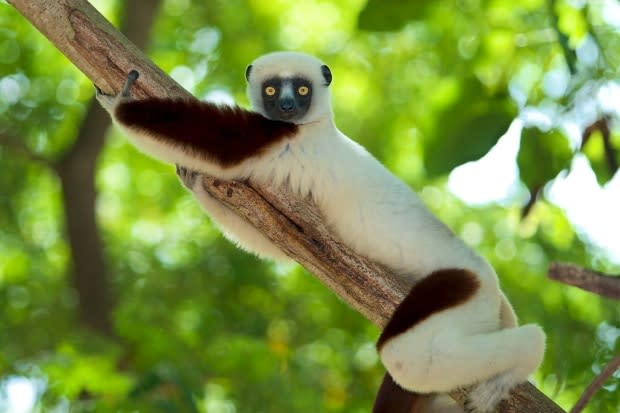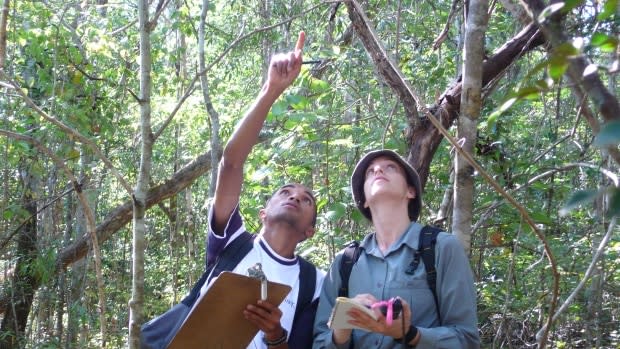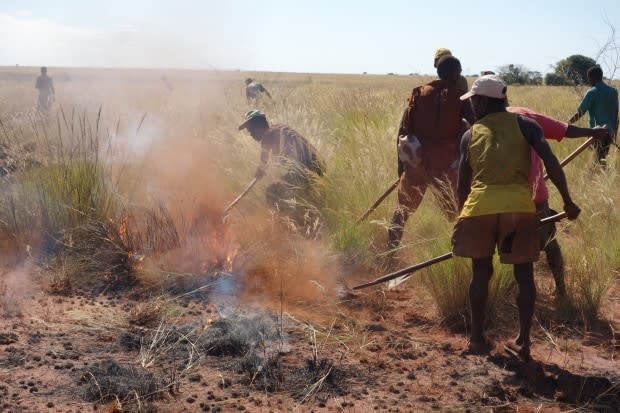Toronto couple make lemur conservation their mission
It's around noon on an October day in Ankarafantsika National Park. It's very hot, and dry, as is usual this time of year in northwest Madagascar, and lemurs are hanging out in a large tree, under which anthropologist Keriann McGoogan also finds herself.
The lemurs continuously move down the canopy until they're seated on the ground of the forest floor. In their quest to find some cool relief, they are unfazed by their human companion.
"I sat down as well and pulled out my snack," McGoogan says.
"It's sort of like I was having a picnic with them."
It's experiences like this one that have shaped McGoogan's perception of the primates.

"They're really not all that different from humans in some ways."
McGoogan, 37, and her partner Travis Steffens, 39, are both anthropologists who have been studying lemurs for over 10 years. They will be at Lemur Awareness Weekend at the Toronto Zoo running Saturday and Sunday from 11 a.m. to 3 p.m. It's all part of the World Lemur Festival, an international series of events in October to raise awareness about the plight of the endangered primates.
There are more than 110 known species of lemurs, 95 per cent of which are threatened with extinction, they say.
McGoogan says it's thanks to TV shows and movies like Zoboomafoo and Madagascar that people even know lemurs exist.
"They are the most endangered mammal group in the world and not many people know they're only found in Madagascar," an island nation off the east coast of southern Africa in the Indian Ocean.
The Calgary couple, who now live in Toronto, are involved in the non-profit organization, Planet Madagascar, of which Steffens is the founder and executive director.
The organization works with the Malagasy people of Ankarafantsika National Park to protect lemurs and their habitats.
Combined, Steffens and McGoogan have spent more than four years in Madagascar studying the rare animals.
Challenges of lemurs
Throughout their time they've come to learn of lemurs' ecological importance in Ankarafantsika.
Steffens says they are important to seed dispersal, which is helpful in improving the diversity of plants within the forest.
Although they are beneficial to their environment, lemurs face challenges within it.
"Lemurs are threatened by a number of things, including hunters and being bought and sold in the pet trade," Steffens says.

Despite looking cute and cuddly, lemurs make a poor pet choice due to their intelligence, strength and strong personality, he says.
McGoogan says their biggest threat, however, is habitat loss due to fires and conversion to agriculture.
She says the Malagasy use fire to clear grasses in order to graze their cattle or grow rice. Although permitted in certain areas, the fires can get out of control and spread into nearby forests.
"The issue with that is lemurs rely on that forest for survival. They live there and they eat the food there."
McGoogan also says there has been a lack of understanding of lemurs' significance among the Malagasy.
They look at lemurs the same way those in Toronto may view raccoons or squirrels. She says it's important to educate communities about lemurs and their endangered status.
"If they go extinct in Madagascar, then that means they're extinct in the world. So we lose them altogether."
Conservation efforts
Planet Madagascar prioritizes conservation, education and community in their efforts to address these threats.
The funding they receive from various organizations and donors allows them to run programs to save the endangered primates.
"In Ankarafantsika we have fire management programs, which include patrol teams and firebreaks," Steffens says.
McGoogan says they have witnessed the success of these programs thanks to the work of the Malagasy.
"A [fire patrol] group decided to go out on their own … without being paid by us. That was a real achievement because it meant that they cared enough to continue the program beyond us facilitating that," she says.
The organization also has measures in place to restore the forest that has been lost due to fires.
"We have a sustainable agricultural project and a forest restoration project through one of our partners, Tontolo Maitso, which is a women's cooperative," Steffens says.
He says between 2018 and 2019 the cooperative will have planted 17,000 trees.

Although lemurs are unique to Madagascar, the same cannot be said of their biggest threat.
"Habitat loss is the main threat to all biodiversity extinction that's happening around the world … and it's usually caused by switching landscapes to agriculture," Steffens says.
He says finding solutions in Madagascar could be beneficial to addressing similar problems elsewhere.
"Because it's this microcosm, we have a chance to actually solve the problems on a fairly large scale, and if that works, we can maybe apply some of those same tools to other regions."
According to the Lemur Conservation Network, October marks the start of World Lemur Festival events, which are happening throughout the month in Madagascar, Canada, the United States, and in the United Kingdom.
McGoogan says their event this weekend at the Toronto Zoo will be fun and educational and that they hope to bring lemur awareness to as many people as possible, especially children.
Her reasoning is simple.
"It would be pretty sad if the next generation didn't know about them."


